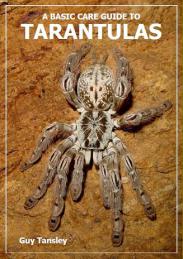
Of the four species representing Heteroscodra Pocock, 1899,
only H. maculata is common in the hobby. Enlargement of the femur of leg iv separates Heteroscodra from the closely
related Stromatopelma.
H. maculata Pocock, 1899 - West,
Central Africa
A small to medium arboreal species that makes up for it's size with it's attitude. H. maculata is very
defensive once disturbed and definitely should not be handled. They will readily assume the threat posture with bared fangs and if the disturbance persists, they will follow through with a bite.
Adult females are coloured with various shades of black, grey and white and the abdomen is spotted with black with a dark median line dorsally. The short, stout legs are striped and spotted and the
rear legs have a distinct thickened appearance. Breeding is a simple affair with a receptive female and their courtship drumming is similar
to Poecilotheria spp. An arboreal breeding set-up should be used for H. maculata. This consists of the
females' container placed into a larger enclosed area and the lid removed. The male is then introduced into this area and can be left undisturbed for several nights. During this time, the male will
visit the female in her container, mate and has ample room to make his escape if needed. The female rarely leaves her container allowing the male to keep a comfortable distance. Multiple mating may
occur during this period. Approximately eight weeks later the egg sac is produced. This is usually attached to the side of the cork bark and guarded fiercely by the female. During incubation humidity
levels should be constantly measured to prevent the eggs from either drying out or being destroyed by mould. The fully mobile spiderlings emerge approximately eight weeks later and number around 140
(some report up to 500). Aggressive feeders, H.
maculata will tackle prey many times larger than itself and growth is reasonably fast in the first
few months. Females can live in excess of ten years reaching 11cms in legspan. Typical arboreal set-up is ideal. Slightly moist compost as a substrate with a slab of cork bark against one side behind
which the spider can build its retreat. More on housing can be found here.

